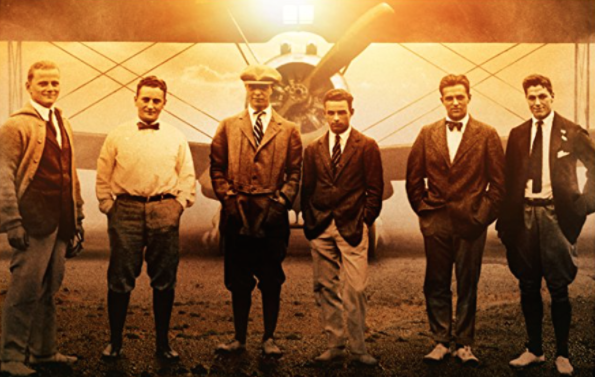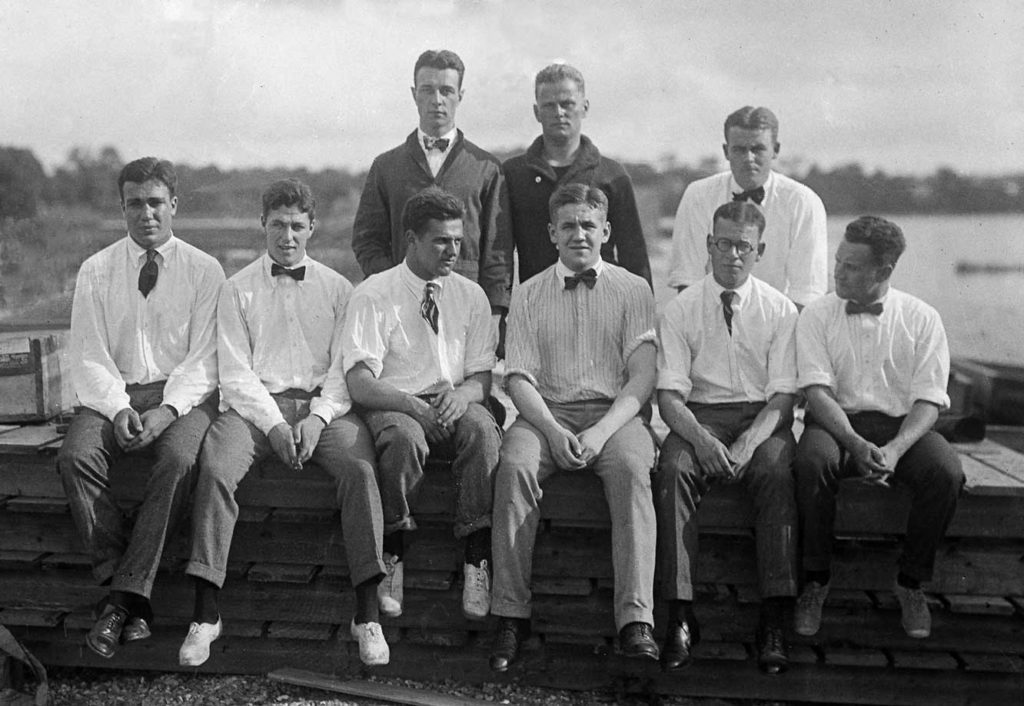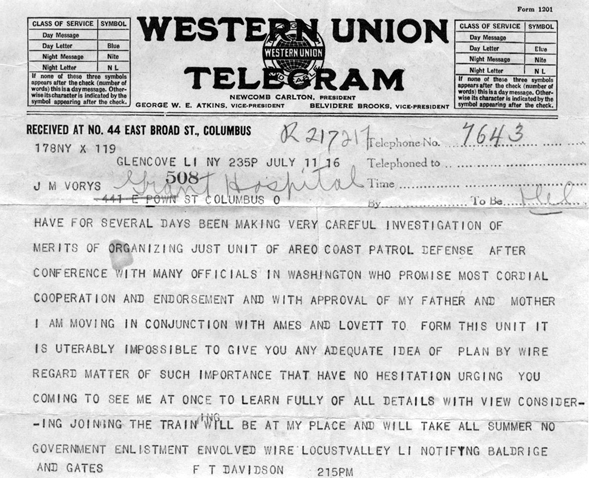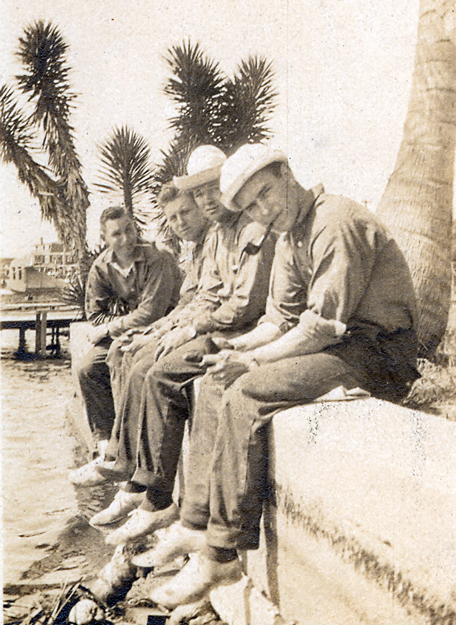
“The little bit of news that was coming out about the war overseas was that this was the biggest event of mankind. In the history of the world. And they wanted to play a part, and they wanted to fly. It was a young person’s energetic dream of adventure, and challenge, and glory.”
DARROCH GREER
Inspired by the book The Millionaires’ Unit by Marc Wortman, the stunning documentary of the same name tells the unsung story of a group of twenty-eight college students, nearly all of them from Yale University, who took the initiative to learn to fly in preparation for America’s entry into World War I and become the founding squadron of the U.S. Naval Air Reserve. The award-winning film was released on VOD last month to commemorate the 100th anniversary of the death of First Yale Unit member Albert D. Sturtevant, the first U.S. Naval Aviator killed in combat, after his plane went down in the North Sea in February 15th, 1918. We spoke with the two filmmakers, Darroch Greer and Ron King (a descendant of the First Yale Unit), about making a documentary on a story to which you have personal ties, how this brave group of college students was able to make history, and what viewers can learn from their dedication.

Hannah: So, Harry Davidson, Mike Davidson, Bruce Dern, and you, Ron, are all grandnephews and grandsons of FYU members. How did everyone come together to collaborate on this?
Ron: When the book [The Millionaires’ Unit] was published, Marc Wortman, the author, found out that I had read it and invited me to attend a panel for the book in New York City at the Yale Club. Harry Davison was there on the panel—that’s where I met him—and Harry introduced me and Darroch to his cousin, Mike Davison, who happens to be the grandson of both Trubee Davison and David Ingalls, both members of the Yale unit. Harry is the grandson of Trubee Davison, the founder of the Yale unit, and I am the grandson of John Vorys, one of the members of the Yale unit. Bruce Dern came to us a little bit later in the process, when we were looking for a voiceover artist. Bruce was introduced to us by one of our advisors on the film named Fred Roos, who is a Hollywood producer and knew Bruce from the past, and also was intuitive—because Bruce’s middle name was MacLeish—that he might have something to do with the story. And sure enough, Bruce turned out to be the grandnephew of Kenny MacLeish, another one of the Yale unit members. So that’s sort of how it all came together.
Darroch: It was rather funny. Both Harry Davison and Mike Davison—cousins—became part of our fundraising team, and Ron and I were very nervous about approaching Harry because somehow we got the idea that he was a big game hunter and that he would be unapproachable and would never return our telephone calls, and that was not the case. But after working with him for a month or two, he said, “You know what, you’ve gotta talk to my cousin Mike. He’s a very energetic, go-get-’em guy, and he’ll really be helpful.” And that’s how we all got together.

Hannah: So when you’re making a documentary that you have personal ties with, like a lot of you do, how do you effectively integrate what you know from, maybe personal stories, with archival footage and facts? What if the overlap between those two things isn’t seamless?
Darroch: First of all, we realized, with Ron originally meeting those families in New York at the Yale club, that there were photographs that the families had, and that that would be a good thing because they would generally be photographs that no one had ever seen before. But then, as filmmakers, you start looking at the story, and start wondering, you know, How can we cover this story? Are we going to cover this with things we’re going to shoot, how extensive is the archival record and photos and film? And then with film, we’re looking at 100-year-old film, which often is not in very good shape. So, sort of as we progress and go through it, we start going to archives and hoping that we’re gonna be able to tell the story with the material out there. And then often, once you see what the material is, you sometimes write to that material. If one aspect of the story is very well covered, we can embellish it in the writing because we have this great footage or photographs to cover it.
Ron: One of the great things about this filmmaking process and the story was the fact that the relatives who we encountered—not just Mike and Harry, but we met several of the descendants—sons and daughters, nieces and nephews, grandchildren of the Yale Unit members, and nearly every family had their own collection of still photographs and memorabilia from the time period, including journals and letters and things like that. As far as, you were asking about what personal stories we knew, or I knew, in the beginning—I really was very uninformed about what the story of the Yale unit was. I knew that my grandfather was naval aviator number 73, but I did not know anything about his history in the Yale Unit prior to working on the film. It turns out that the Davison family, who we’ve mentioned a couple of times, actually were the first to publish an extensive history on the Yale Unit, that they published back in the 1920s. It was actually sponsored by the Davison family. They reached out to all of the Yale Unit members who were alive, and they all of course were alive at that time, except for the ones who didn’t make it through the war. And they all sent back their letters and things like that to the author of that book, which turned out to be a two-volume set that was published and then given to libraries around the country, so that people had a little bit of information about the history of the Yale Unit. So I knew of the existence of that book, but I had never read it. And then Marc Wortman’s book came out, and that was really where I learned everything about the Yale Unit—from those two publications. And then, of course, over seven years of making the film, Darroch and I did a tremendous amount of research through archival footage. And Darroch is a historian deeply into World War I and its causes, which we put into the film so that we set our little story in the context of the much larger story. So there was a lot to work with, let’s put it that way. But I started knowing very little.
Darroch: Yeah, me too.
Cailin: I guess that made it more interesting for you, because you were kind of, through the whole research process and making the film, learning in the same way that they viewer would as they’re watching it.
Darroch: Yes, very much so.

Cailin: So, I was most drawn to the story just because of the instant admiration I had for these college students—I mean, they’re even younger than we are now—who took it upon themselves to actually sacrifice their safety to work toward something that would eventually have this massive impact on the entire country, and the war. The part of the documentary that showed that their first obstacle was to convince their parents to allow them to learn to fly just really drove home just how young they were to be on a mission like that. Do you think that part of the reason why they were successful was that they still had this idea that we all have when we’re young that we can do anything, because no one’s really told us enough times, “No, you can’t do this, you can’t do that”? Do you think it was that confidence that they had that helped them do what they did?

Ron: I will say that in the beginning, they certainly had that sort of unbridled enthusiasm about trying to put together this unit. You know, it really was the brainchild of Trubee Davidson and then very quickly thereafter Bob Lovett to do this. So they were undaunted in their desire to put this all together. And they wouldn’t take no for an answer, even from the government. But it has to be pointed out that these were not just any guys. These were people who had means at their disposal. Because of the family’s wealth, they were able to get a training school dedicated to just their training, back then, to learn how to fly. I mean, this was something that a normal, everyday person couldn’t necessarily do. And then, of course, as they progressed in their training, they actually got a lot of support from the families back in those days, and from the J.P. Morgan company, which gave them 100,000 dollars early on to get the unit going. So not only did they have the youthful idealism and enthusiasm to get the project going, they also did have the means to actually make it happen.
Hannah: Well, that’s important.
Darroch: I can add to that as well. You know, they were certainly patriotic. They certainly felt very strongly about their country, and their parents were captains of industry, so they felt an incumbent upon themselves to contribute to that. They also, because of their wealth and their intelligence, they really could do anything they wanted. And a decade and a half before the war came along, the frontier in America had closed; it had all been explored. Explorers had been to the North Pole, they’d been to the South Pole, and sort of a new frontier of adventure was aviation. This was an incredibly exciting new technology. And also, the little bit of news that was coming out about the war overseas was that this was the biggest event of mankind. In the history of the world. And they wanted to play a part, and they wanted to fly. It was a young person’s energetic dream of adventure, and challenge, and glory. So it appealed to almost all of them. Plus, they had a bond. They were fraternity brothers, they were in school together, and they weren’t going to let each other down. There were several members that really should not have been pilots at all, and a few of them really paid the price for that. And yet, they really felt a real brotherhood to go out on this adventure together and risk their lives.

“It really has a perfect, dramatic, arc for a narrative movie or a miniseries. You’ve got the intellectual guy who’s really smart and hard-driving and is going to make sure that they’re going to be successful. You have the leader whom everyone admires, and yet he’s injured and has to drop out of the whole operation. You have the cowardly guys, you have the romantic figure.”
DARROCH GREER
Cailin: You mentioned their bond…the film makes it a point to introduce the personalities of each member: some of them were shy, others were more outgoing, some were serious, others were a little bit more light-minded. How do you feel the mix of personalities influenced the way they worked together as a team?
Ron: Well, one of the things that became very clear to us in making the movie and doing the research is we found that the members of the Yale Unit really looked to each other for character examples. You know, they set up their own personal character based on what they felt their friends were committing to. You’re talking about teamwork and how did that build, well, that was a big part of it. They had a very visionary leader in Trubee Davison that put this unit together and got them started with their training, and Bob Lovett, who eventually ended up being the Secretary of Defense later on, was very, very influenced by Trubee’s leadership. He says in his letters, “What I’m doing over here, I couldn’t have done without you, without your training and leadership in the beginning.” They really influenced each other, and they really looked to each other as a source of building their own character, I think.
Darroch: And not only could they all fit into the different jobs that needed done by the navy and by naval aviation, looking at the story, it really has a perfect, dramatic arc for a narrative movie or a miniseries. You’ve got the intellectual guy who’s really smart and hard-driving and is going to make sure that they’re going to be successful. You have the leader whom everyone admires, and yet he’s injured and has to drop out of the whole operation. You have the cowardly guys, you have the romantic figure. It was really quite remarkable. We just needed to find the right material, put it in context, and find airplanes to film.
Cailin: You already had the characters!
Ron: Yep.

Hannah: Last question for you, Ron and Darroch. What do you both most want people to learn about the FYU members by watching the film? I’m sure there are a lot of people like us who, when they went into this, just had no idea about the story at all. What do you most want people to take away?
Darroch: I would want people to take a look at what it means to go to war, and what’s required to go to war, and how to make those personal judgments and those personal calls. I also hope that the mettle of these men would inspire people to look outside themselves to see how they contribute to society, or to their country, or to their government, and understand that there’s a lot to be gained from taking the initiative. Being a leader and being a contributing member. I think they’re wonderful examples of how to serve your society and your family.
Ron: I would agree with that. The other thing that I admire about the members of the unit that we discovered as we were making the film is that they really looked, I think, very deeply into their own lives and their own activities, and they wanted to try to communicate that to both the other members of the unit and also their family and friends back home. So one of the wonderful things about the film and about the research going into the film was to be able to read their personal letters from the period. You know, they were classically trained in terms of their education, and a few of these guys were just very, very good letter writers. They really put their heart and soul into the letters, and they tried to explain their commitment to the cause, their religious views on things, the way that their actions were affecting the other members of the unit, the deep sorrow that they had for the losses of the members of the unit…they really tried to communicate who they were, which I think is also admirable. It wasn’t just off-the-cuff type stuff. I think they really dug deep and tried to communicate it.
The Millionaires’ Unit is now available to watch on video on demand.

Thank you for this beautiful reminder!